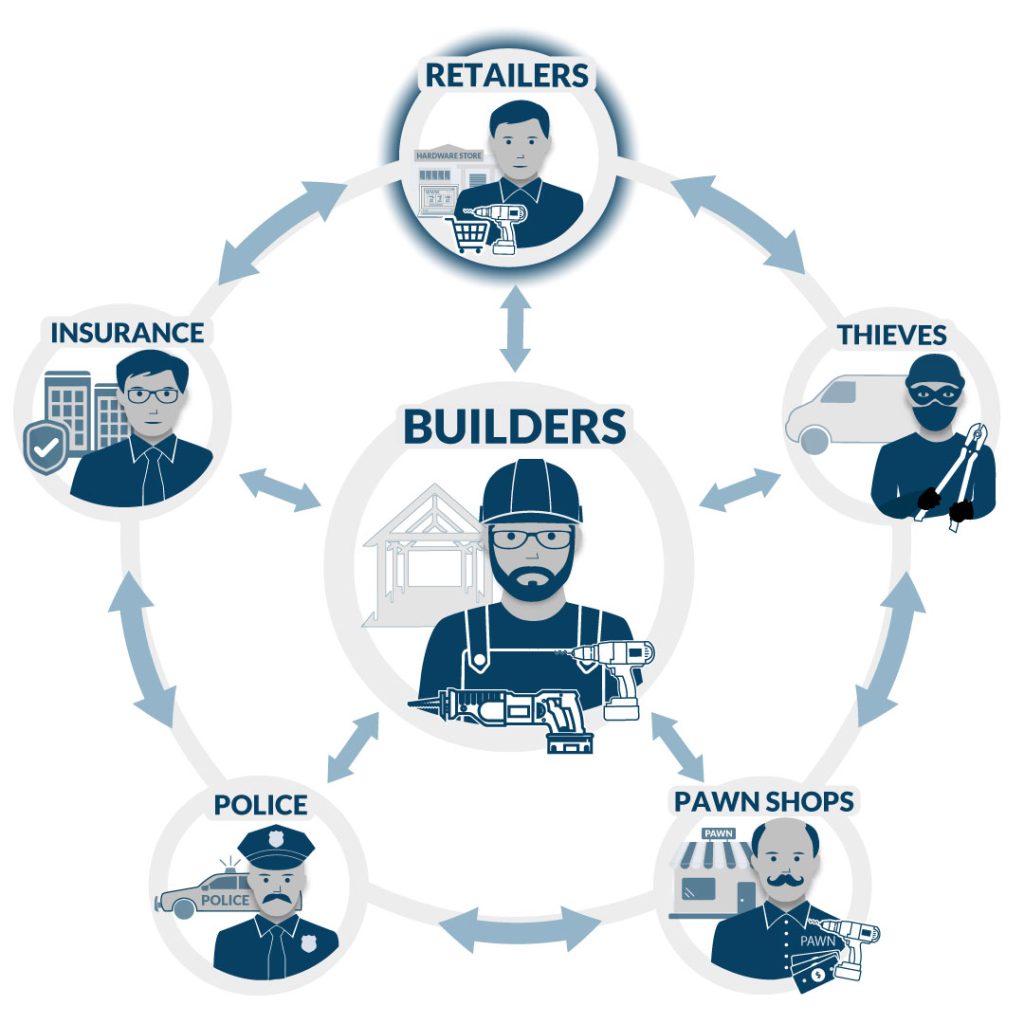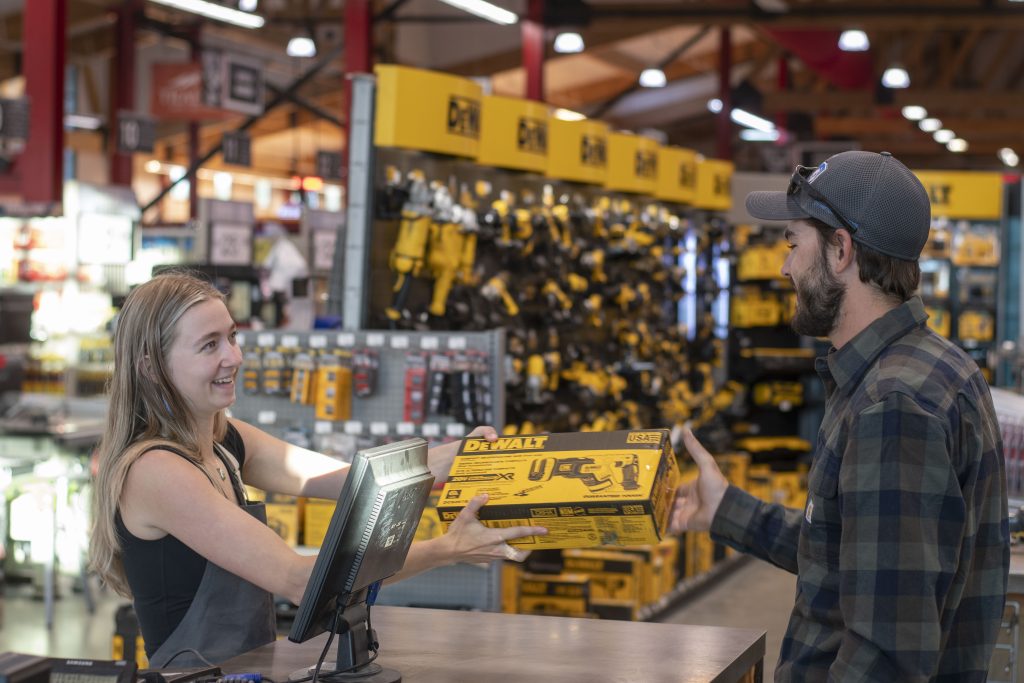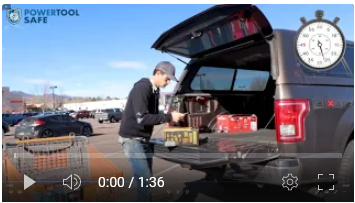If tool tracking actually worked, wouldn’t everyone use it? There are a ton of solutions out there, Milwaukee’s ONE-KEY, Dewalt’s Tool Connect, Hilti’s ON!Track to name a few. One of the problems is that these programs are typically brand specific and mostly offer functions that only cater to built-in features specific to their brand. They do have tool tracking capabilities and tool management benefits, but they mostly cater to their own product with benefits focused only on the end user.
Don’t get me wrong, these are still great ideas that do help a lot of builders, but in my over 30 years in construction I’ve never seen a builder shows up with only one brand of tools. A huge limiter of success for these apps is the ability to work across multiple brands the same way. Also, these apps were designed as a selling feature for the manufacturer’s products. So do they actually solve the problem of theft for the builders? You decide.
The Real Problem Builders Face
As builders, we all face the same problems and we all have the same issues. When I ask carpenters, plumbers, electricians, roofers, and general contractors what are the the biggest issues they face when it comes to everything tool related, I get the same answers. Every time. They worry about theft, they don’t have a way to keep good records, employees are breaking and losing tools, they don’t have the manpower to keep up with their work load, and they just don’t have the time to organize their equipment and keep good records.
There is only so much any of us can do on any given day.

Tool tracking doesn’t work because most tool tracking programs fail to see the bigger picture. But it’s real simple. Theft affects everyone. Builders buy tools, they break, get lost or stolen. Pawn shops have a problem buying/not buying stolen tools. Insurance claims are filed when builders who are organized and have theft insurance take a hit. Even retailers are affected by people walking out of the store with merchandise.
Retailers Face the Same Problems
There are two life-cycles of a tool. The one we know best goes like this: A Retailer sells a tool to a builder, the builder uses the tool, it gets lost or stolen, the builder files a police report, possibly an insurance claim. The builder searches pawn shops and hopefully, between the builder, the police officer and the pawn shop, everyone is on the look out for the thief. This cycle has less than a 25% rate of success in tool recovery.
And why is it so easy for thieves to steal tools? Because virtually NOBODY has records.
Did you know that theft costs the construction industry over $1.5B every year, but inventory shrinkage (retail stores) lose almost $50B annually? They take a bigger hit than the construction industry, and that’s merchandise walking out the front door. The most common items stolen? Power tools, sunglasses and jewelry, and electronics. Home Depot lost over $100 Million in merchandise last year alone. Now, think of the same tool-life cycle and replace the builder with the retailer. The process is the same, and the same people are affected.
A true solution benefits everyone.

Did you know that most power tool brands put the serial numbers on the box? All the information you need to create a tool record is available without even opening the box. How do we know? We do it. We built a database of power tools and UPCs. We know exactly whats in the box just from the UPC. Then we attached warranty info to that UPC, links to tool manuals and links to replacement parts for each tool. Why? Because we are builders. We actually know what information you need access to. So far, we’ve done this for all the models of over 135 different brands. We don’t care if its Makita, DeWalt, Milwaukee, Ryobi, Craftsman, FLEX. You buy a tool, you need access to tool info. It shouldn’t matter the brand.

As of our last update, our database currently has over 199 brands, 31,000 models, 4,600 kits and 3,700 stock images so we can automatically create tool records and help you track warranties, locate manuals and replacement parts all with the click of a button.
With that database, when we see a UPC, we can create tool records from that UPC alone, then attach the serial numbers that are also on the box. We go so far as to attach a copy of the receipt to each tool associated with the purchase. And just like that, now you have instant tool records from photos with a proof of purchase attached so you can track warranty periods, access tool manuals and replacement parts for all these brands.
More importantly, since we know police officers are tasked with helping us (builders AND retailers) recover stolen goods, tool records are added to our database to help both police and pawn shops check the status of a tool and instantly notify the appropriate parties when a tool in the data base is searched. So now we have tool tracking that actually helps police officers, pawn shops, and builders are communicate and share tool information and status.
Here’s where it gets interesting. When you add tools to your account, you are essentially building your own tool “inventory.” A retailer uses a software program to manages their inventory against their sales. They use a Point of Sale (POS) system. If their POS system allows them to attach a serial number to a SKU, (the stores own product number that identifies a manufacturer’s UPC), then tools can be entered to a stores inventory. This essentially registers the tool to the store until it is sold. When that tool is sold, we have the ability to transfer that serial number to the customer.
Its really this simple. When a store receives a shipment from Dewalt, they add the new shipment to their inventory, all they have to do is attach serial numbers from the tools they received to the inventory in their system, these tools are now showing as the property of the store. If someone walks out the front door with the tool, its already in the database as belonging to the store, so if a pawn shop or police officer check the serial numbers in the database, they learn the tool still belongs to the store and the store is instantly notified.
How can we do it so easily? Because the same tool we built to help a user create records from a photo can be used by a police officer to scan a UPC and a serial number, then instantly check it against our system. Information supplied to officers, notifications sent to tool owner.
Boom. Problem solved for everyone using the same solution.

When retailers want to get serious about solving their own problems, the true solution will benefit everyone. Even crazier yet is that when a retailer understands this and implements this solution, that retailer will gain a marketing advantage, it will offer its customers more value, and that retailer will get to take credit for everything. They will get to say, “We gave you tool tracking, we helped reduce theft in your communities, we gave you all the tools you need to protect your equipment.”
Until then, tool tracking will work only in limited capacities. But yes, we still offer the most comprehensive solutions to date. We are adding virtual name tags to your tools, and adding them to a database to help you, police and pawn shops all gain the upper hand against thieves.
So sign up for an account, help grow our voice, and if the retailers don’t want to get there on their own, let’s demand it.
SIGN UP and we’ll complete your first 5 tool records straight from your photos for FREE.
What do YOU have to lose?


